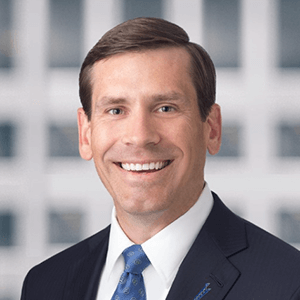MARKET UPDATE
Opportunity Amid Transition
The fourth quarter begins with markets balancing cautious optimism against a still-fragile policy backdrop. After a volatile year defined by policy swings and geopolitical tension, investors are confronting fresh uncertainty from a partial U.S. government shutdown, renewed trade friction with China, and another round of tariff and export control measures. Yet despite these headwinds, financial conditions remain relatively stable, corporate earnings are holding up, and inflation is in check.
Markets have taken the government shutdown in stride, viewing it as more of a political impasse than a fiscal crisis. Still, the lapse in government funding delays economic data releases and clouds near-term visibility for policymakers. The larger story, however, is the persistence of global policy friction. In early October, the U.S. announced an additional 100% tariff on select Chinese goods and tightened export restrictions on advanced technologies, drawing the prospect of retaliatory measures from Beijing. The new trade actions underscore that global supply chains are once again being reshaped by policy rather than market forces — a dynamic that could weigh on margins and trade volumes as the year closes.
Meanwhile, the Federal Reserve finds itself at a delicate crossroad. Its credibility is under attack from multiple directions — political pressure from Washington, investor skepticism over its inflation commitment and the lingering perception that policy has become reactive rather than proactive. The good news is that its most recent meeting provided a degree of reassurance: Federal Reserve Chair Jerome Powell signaled that balance sheet runoff could conclude early next year and reaffirmed that rate decisions remain data-dependent, not politically driven. That message, modest as it was, gave markets hope that true independence may yet be restored.
Beyond the headlines, the market narrative is gradually shifting from one of anxiety to adjustment. Headline inflation is easing, growth remains positive, and the long-feared recession has yet to materialize. Equity indexes have recovered sharply from their April lows, credit spreads have narrowed, and volatility has fallen back toward pre-pandemic averages. Yet complacency would be premature. Investors are navigating a transition marked by slower growth, high nominal rates and elevated political risk — conditions that reward discipline and selectivity more than broad risk-taking.
“It is fair to say that the outlook for employment and inflation does not appear to have changed much since our September meeting […] growth in economic activity may be on a somewhat firmer trajectory than expected.” 1
— Federal Reserve Chair Jerome Powell
A YEAR OF ADJUSTMENT AND RESILIENCE
2025 has been a year of extraordinary adjustment. The spring’s tariff shock and midyear policy volatility tested investor conviction, but the economy proved resilient. The passage of the One Big Beautiful Bill Act (OBBBA) provided fiscal clarity, making several tax provisions permanent while keeping new spending contained. Inflation data consistently surprised to the downside through the summer, while corporate earnings proved more durable than expected. By October, financial conditions had eased meaningfully, supported by the cooling inflation and renewed confidence that the Fed might manage an orderly transition back to policy easing.
The result is a more balanced market environment — less driven by liquidity and more by fundamentals. Investors are focusing on earnings quality, balance-sheet strength and sustainable margins rather than speculative growth narratives.
Year-to-Date Performance
Sources: S&P 500 Index, Dow Jones, NASDAQ, Russell 2000 Index as of 10/16/2025.
Past performance is not a guarantee of future results.
ECONOMIC LANDSCAPE: SLOWER GROWTH, FIRMER FOUNDATIONS
The U.S. economy continues to downshift without derailing, reflecting softer consumer spending, slower job creation and tariff-related drag on trade volumes. Still, the underlying picture remains constructive. Household balance sheets are healthy, housing demand is stabilizing as mortgage rates drift lower and corporate reinvestment remains steady, particularly in technology infrastructure and supply-chain localization.
The labor market is cooling but not collapsing. Job growth has moderated, especially in export-oriented industries, yet layoffs remain limited and wage growth is easing in line with productivity gains. Inflation is still above the Fed’s target, with some headline numbers trending lower, as core measures are expected to end the year between 3.0% and 3.5%.
POLICY: INDEPENDENCE UNDER PRESSURE
The Federal Reserve remains the anchor of market sentiment, even as its independence is questioned. Persistent political scrutiny — heightened by the shutdown and public criticism from both parties — has raised concerns that monetary policy could become an extension of fiscal priorities. While Chair Powell’s latest remarks helped calm those fears, restoring full credibility will require consistent communication and policy restraint.
The announcement that balance sheet runoff could end early next year was viewed as constructive but secondary to the broader question of its autonomy. Markets are already looking ahead to the next phase: a gradual easing cycle continuing through early 2026, driven by disinflation, rising unemployment and expectations for below-trend growth. Whether the Fed can execute the pivot without political interference will be a defining test for its institutional legitimacy — and a key driver of market confidence heading into next year.
Fiscal policy, by contrast, remains relatively neutral. The OBBBA’s extensions of business tax incentives provide some support for capital investment, while gridlock in Congress limits the prospect of large new spending initiatives. Combined, fiscal and monetary policy are transitioning from restrictive to balanced — an environment conducive to steady but unspectacular growth.
Corporate Bond Spreads
Sources: Bloomberg U.S. Agg. Corporate Avg. OAS, Bloomberg U.S. Corporate High Yield Average OAS as of 10/10/2025.
Past performance is not a guarantee of future results.
MARKETS: CONSTRUCTIVE, BUT SELECTIVE
Equities have climbed to near record highs, supported by resilient earnings and improving visibility on inflation. Profit margins remain healthy, particularly in sectors tied to technology and industrial automation. Importantly, much of this year’s rally has been driven by earnings growth rather than multiple expansion — a sign of underlying corporate strength.
Fixed-income markets have stabilized as yields approach a plateau. Intermediate-duration bonds now offer compelling real yields, while credit spreads remain tight but reasonable given fundamentals. The risk-reward balance between equities and fixed income is more even than at any point in recent years.
Gold and other real assets continue to benefit from global diversification demand as investors hedge against policy uncertainty, currency weakness and fiscal slippage.
GLOBAL DYNAMICS: TRADE TENSION AND CAPITAL REALIGNMENT
Global conditions remain defined by the interplay between policy and capital flows. The escalation of U.S.–China trade measures, coupled with export controls on advanced semiconductors, highlights the ongoing fragmentation of global supply chains. Both sides appear intent on protecting strategic industries, even at the cost of slower global growth.
At the same time, the dollar’s recent softness and moderating U.S. yields have encouraged renewed capital flows into non-U.S. markets. Select emerging economies and commodity producers are benefiting from this rebalancing, though global growth remains uneven.
RISKS TO MONITOR
While the near-term outlook is constructive, key risks remain:
- Policy Missteps: An extended shutdown or political interference in Fed policy could undermine confidence.
- Margin Pressure: Higher input and tariff costs may squeeze profitability if demand weakens.
- Geopolitical Escalation: Retaliatory trade measures or export restrictions could disrupt supply chains.
- Fiscal Credibility: Rising debt service costs could weigh on Treasury markets and long-term yields.
- Labor Market Friction: Slower hiring could dampen sentiment and delay consumption recovery.
THE BOTTOM LINE
The fourth quarter opens with cautious optimism but no shortage of complexity. The economy continues to adjust, inflation is trending lower and markets have proven resilient in the face of policy uncertainty. Yet credibility — both fiscal and monetary — remains the central challenge. The latest Fed meeting offered a reminder that independence can still be asserted, even amid political crosswinds.
Investors should remain balanced and discerning. Opportunities persist, but so do risks tied to policy, trade and confidence. In this environment, fundamentals matter most — quality balance sheets, stable cash flows and disciplined allocation remain the surest guides through what promises to be another consequential quarter.
- Powell, Jerome H. (October 14, 2025). Understanding the Fed’s Balance Sheet, speech at the 67th Annual Meeting of the National Association for Business Economics, Philadelphia, Pennsylvania. https://www.federalreserve.gov/newsevents/speech/powell20251014a.htm
EQUITY
Market Breadth Returns
The third quarter of 2025 delivered exceptional performance for U.S. equity markets, with major indices achieving new all-time highs and demonstrating remarkable resilience. The S&P 500 rose 8.1% during the quarter, while the tech-heavy Nasdaq surged 11.4%, as investors embraced renewed optimism around artificial intelligence, corporate earnings strength and the Federal Reserve’s pivot to monetary easing.
The quarter marked a pivotal shift in market leadership. Small caps beat out their large-cap peers, rising 12.4%, with the Russell 2000 Index reaching an all-time high in late September, eclipsing the prior high reached over four years ago. This small-cap resurgence, fueled by rate cut optimism, represented a significant broadening of the market rally beyond mega-cap technology stocks.
Technology and artificial intelligence remained the dominant narrative driving market performance. The “Magnificent 7” stocks gained 17.6% during the quarter. The S&P 500 closed above 6,700 by early October, extending its year-to-date rally to about 15%. Corporate capital expenditure in AI infrastructure continued at record levels, reinforcing investor conviction in the technology’s transformative potential.
2025-Q3 Sector Leadership (S&P 1500)
Source: S&P 1500 as of 9/30/2025.
Past performance is not a guarantee of future results.
The Federal Reserve delivered its first rate cut of 2025 in September, reducing policy rates by 25 basis points, with policymakers’ median projection indicating two additional cuts are expected this year. While largely anticipated, the nearly unanimous Federal Open Market Committee (FOMC) decision signaled coordinated monetary accommodation as labor market concerns intensified.
Sector performance reflected continuation of growth-oriented leadership. Growth stocks, particularly those with ties to AI, continued to outperform their value stock peers, as the Russell 1000 Growth Index gained 10.5%, while the Russell 1000 Value Index rose roughly 5.3%. The Information Technology and Communication Services sectors led quarterly gains. Consumer Staples faced pressure with a -3% return, the only sector to end lower in Q3. Healthcare struggled to keep up with its growth peers as drug pricing reforms and operational costs weighed on the sector.
The estimated earnings growth rate for Q3 2025 is 7.1%, marking the ninth consecutive quarter of year-over-year earnings growth. As the quarter closed, markets faced the commencement of a government shutdown beginning October 1, 2025, with the S&P 500’s modest decline reflecting measured concern rather than panic.
2025-Q3 Equity Returns
Sources: S&P 500, Magnificent 7 Stocks, NASDAQ Composite Index, Russell 1000 Growth Index, Russell 1000 Value Index, Russell 2000 Small-Cap Index as of 9/30/2025.
Past performance is not a guarantee of future results.
INVESTMENT GRADE FIXED INCOME
Late Quarter Rally Boosts Performance
Investment-grade (IG) fixed income extended its performance streak into the third quarter, with gains across all major sectors of the market. An eventful September was the primary catalyst of price support as mixed economic data and the Fed’s first cut of the year led to lower yields.
Bloomberg U.S. Corporate IG and Treasury bond indices earned a solid 2.6% and 1.5%, respectively, further improving their year-to-date (YTD) returns to 6.9% and 5.4%, respectively. One observation of note is the return profile between global and U.S. markets YTD, with early-year U.S. dollar weakness leading to international bond markets outperforming on a relative basis this year. Shifting to municipal bonds, this market segment recovered nicely from first half of year challenges to notch the strongest quarterly return since 2011, or 3%, bringing YTD performance to 2.6%. Many themes that helped bonds earlier in the year continue to play out in the fixed-income markets — steady credit fundamentals and technical tailwinds — that are likely to benefit fixed-income investors at least in the near-term.
A topic of discussion this year has been bond supply, but the issuance trends tell two stories between corporates and municipals. During the third quarter, IG corporate gross supply was rather muted, and YTD is about 2% above the previous year. With healthy corporate balance sheets and profitability, new issue concessions remain tight as demand persists. In municipals, new issues are about 15% higher YoY and up more than 50% vs. the 5-year average for the period.
Municipal bond sales are on track to reach record levels in 2025 in part due to the pull-forward in some sectors such as higher education and governmental entities concerned about implications from the One Big Beautiful Bill Act, but project cost inflation is also a reason. Steady investor demand helped absorb bonds, but any break in the supply and demand balance could lead to attractive entry points in the fourth quarter.
Against the backdrop of mostly stable credit quality and issuer capacity to navigate potential economic headwinds and policy uncertainty, credit spreads have remained compressed and valuations full. Perhaps an exception, long maturity municipal bonds remained relatively “cheap” in the early months of the quarter, but despite a more prominent decline in municipal yields vs. comparable Treasuries in September, this part of the curve continues to offer value.
In the near-term, risk compensation is likely to remain within a tight range, supported by fundamentals, but a slowing of economic growth beyond expectations could cause credit spreads to widen from current levels in corporates and municipals. Given these dynamics and the potential peak in further quality gains, a continued focus on issuer and sector selectivity is a prudent approach to sourcing portfolio bonds. Absolute yields remain attractive and continue to provide compelling opportunities for investors to “lock in” cash flows (absolute and taxable-equivalent basis for municipals). In the near-term, investors with appropriate risk controls can take advantage of market opportunities to construct a diversified portfolio of fixed-income bonds to meet their objectives.
HIGH-YIELD FIXED INCOME
Positive Return Potential as Markets Rally & Yields Moderate
High-yield (HY) bond markets generated another quarter of positive total returns as credit spreads remained tight and interest rate volatility subsided. Investors were encouraged by inflation data, stable corporate earnings and a more balanced policy backdrop.
After peaking midyear, yields drifted modestly lower yet continued offering attractive income opportunities relative to investment-grade and U.S. Treasury benchmarks. Improved risk sentiment supported steady inflows and robust new issue activity that allowed many issuers to refinance their debt at more favorable levels.
Credit fundamentals remain healthy, with generally well-capitalized corporate balance sheets; stable leverage metrics, as evidenced by net debt to Earnings Before Interest, Taxes, Depreciation and Amortization (EBITDA) between 4x and 5x; and defaults trending below historical averages (between 1% and 2% over the past 12 months). Within the market, CCC-rated bonds outperformed in a beta-driven rally (+4.4%), and BB-rated issuers also delivered solid returns of about 2.3% as of Q3, 2025.
High-Yield Bonds Offer Attractive Income
Source: Bloomberg as of 9/30/2025.
Past performance is not a guarantee of future results.
Prices and valuations appear expensive, which means security selection and sector positioning are important in the fourth quarter and into next year.
High-yield municipal bonds also participated in the rally, which helped push the asset class into positive territory throughout the year. Both stable issuer quality and technical tailwinds (e.g., moderate supply and strong reinvestment demand) were primary drivers of performance. With taxable equivalent yields above 9.5% as of 9/30/2025, HY municipals remain a highly competitive alternative to traditional taxable options. Despite compressed spreads, HY municipals continue to offer opportunities across several sectors, including select land-secured financings.
Looking ahead, yield “carry” should remain the dominant driver of total return given the more limited room for further spread tightening. With security valuations back near their cycle lows, credit due diligence and bond/sector selection across diversified exposures across corporate and municipal segments will be critical to sustaining performance into year-end. Furthermore, income continues to mitigate the affects of market volatility and provide investors with competitive risk-adjusted return potential.
Bloomberg U.S. Corporate High-Yield Average OAS
(Option-Adjusted Spread)
Source: Bloomberg U.S. Corporate High-Yield Average OAS as of 9/30/2025.
Past performance is not a guarantee of future results.
THE FED
The Fed is Between a Rock and a Hard Place
Since 1977, the Federal Reserve has had a congressional mandate to support the goals of maximum employment and stable prices. For the past few years, the Fed has been focused on the inflation mandate, since inflation has been running above the target rate of 2.0% while the labor gains have been robust, keeping the unemployment rate hovering around 4.0%.
Although the unemployment rate hasn’t changed much this year, the number of new workers being added to payrolls has slowed substantially, reflecting lower growth in demand and supply (see chart).
Nonfarm Payrolls: Monthly Change
'000, seasonally adjusted
Source: Bureau of Labor Statistics as of 10/21/2025.
Past performance is not a guarantee of future results.
With downside risks to employment increasing, the Fed is concerned — and all members appear to agree. Thus, last month they resumed their rate cutting, which began in September of last year and ended in December.
But it is a confusing time for the Fed. There is a debate among the members over what currently is the greatest threat to the economy: inflation, which has been above the target rate of 2.0% since 2021, or the slowing job market? When the Fed met last month, the 19 members each cast a vote for their outlook on the year-end federal funds rate. The median was two more 25 basis-point (bps) rate cuts, with a range of one voter not expecting any more cuts to another wanting a decline of 150 bps. That is a wide dispersion for a three-month outlook, clearly indicating a great deal of uncertainty about how monetary policy will best help the economy. Complicating this further is the federal government shutdown, which prevents the release of government economic data.
The Fed cut another 25 bps in October. We believe the Fed will cut again at their final meeting in December, bringing the median rate down to 3.625%. For 2026, we expect 1 to 2 cuts. The cuts next year are predicated on the belief that inflationary pressures will resume their decline.
IMPORTANT INFORMATION
The views expressed represent the opinions of City National Rochdale, LLC (CNR) which are subject to change and are not intended as a forecast or guarantee of future results. Stated information is provided for informational purposes only, and should not be perceived as personalized investment, financial, legal or tax advice or a recommendation for any security. It is derived from proprietary and non-proprietary sources which have not been independently verified for accuracy or completeness. While CNR believes the information to be accurate and reliable, we do not claim or have responsibility for its completeness, accuracy, or reliability. Statements of future expectations,estimates, projections, and other forward-looking statements are based on available information and management’s view as of the time of these statements. Accordingly, such statements are inherently speculative as they are based on assumptions which may involve known and unknown risks and uncertainties. Actual results, performance or events may differ materially from those expressed or implied in such statements.
All investing is subject to risk, including the possible loss of the money you invest. As with any investment strategy, there is no guarantee that investment objectives will be met, and investors may lose money. Diversification may not protect against market risk or loss. Past performance is no guarantee of future performance.
There are inherent risks with equity investing. These risks include, but are not limited to stock market, manager, or investment style. Stock markets tend to move in cycles, with periods of rising prices and periods of falling prices.
There are inherent risks with fixed income investing. These risks may include interest rate, call, credit, market, inflation, government policy, liquidity, or junkbond. When interest rates rise, bond prices fall.
Bloomberg risk is the weighted average risk of total volatilities for all portfolio holdings. Total Volatility per holding in Bloomberg is ex-ante (predicted) volatility that is based on the Bloomberg factor model.
Municipal securities. The yields and market values of municipal securities may be more affected by changes in tax rates and policies than similar income-bearing taxable securities. Certain investors’ incomes may be subject to the Federal Alternative Minimum Tax (AMT), and taxable gains are also possible. Investments in the municipal securities of a particular state or territory may be subject to the risk that changes in the economic conditions of that state or territory will negatively impact performance. These events may include severe financial difficulties and continued budget deficits, economic or political policy changes, tax base erosion, state constitutional limits on tax increases and changes in the credit ratings.
City National Rochdale, LLC is an SEC-registered investment adviser and wholly-owned subsidiary of City National Bank. Registration as an investment adviser does not imply any level of skill or expertise. City National Bank is a subsidiary of the Royal Bank of Canada.
© 2025 City National Bank. All rights reserved.
INDEX DEFINITIONS
Bloomberg Global Aggregate Total Return Value Unhedged Index is a multi-currency, investment-grade fixed-rate bond index that includes government, government-related, corporate, securitized (mortgage-backed, asset-backed, and commercial mortgage-backed) bonds from both developed and emerging markets, with the "unhedged" aspect meaning it does not account for foreign currency fluctuations, providing a measure of global debt performance without the impact of currency hedging.
Bloomberg Investment Grade Index: The Bloomberg US Investment Grade Corporate Bond Index measures the performance of investment grade, corporate, fixed-rate bonds with maturities of one year or more.
Bloomberg Magnificent 7 Total Return Index: Bloomberg Magnificent 7 Total Return Index is an equal-dollar weighted equity benchmark consisting of a fixed basket of 7 widely-traded companies classified in the United States and representing the Communications, Consumer Discretionary and Technology sectors as defined by Bloomberg Industry Classification System (BICS).
Bloomberg Municipal Bond Index: The Bloomberg US Municipal Bond Index measures the performance of investment grade, US dollar-denominated, long-term tax-exempt bonds.
Bloomberg Municipal High Yield Bond Index: The Bloomberg Municipal High Yield Bond Index measures the performance of non-investment grade, US dollar-denominated, and non-rated, tax-exempt bonds.
Bloomberg U.S. Agg Corporate Average OAS (Option-Adjusted Spread) is a measure of the average option-adjusted spread for the Bloomberg U.S. Aggregate Corporate Bond Index. This index tracks investment-grade corporate securities and the OAS represents the premium investors receive over U.S. Treasury securities for taking on credit risk, adjusted for embedded options.
Bloomberg U.S. Corporate High Yield Average OAS (Option-Adjusted Spread) is a measure that reflects the average yield spread above the risk-free rate for bonds included in the Bloomberg U.S. Corporate High Yield Bond Index. This index tracks the performance of US dollar-denominated, fixed-rate, high-yield corporate bonds.
Bureau of Labor Statistics (BLS) is a U.S. government agency that serves as the principal federal agency for measuring labor market activity, working conditions, and price changes in the economy.
Dow Jones Industrial Average (DJIA) tracks thirty of America’s biggest and most established companies, acting like a quick temperature check of the U.S. economy.
Nasdaq 100 Index is an index composed of the 100 largest, most actively traded U.S. companies listed on the Nasdaq stock exchange.
Nasdaq is a global electronic marketplace for buying and selling securities. Its name was originally an acronym for the National Association of Securities Dealers Automated Quotations.
Russell 1000 Growth Index is a stock market index that measures the performance of the large-cap growth segment of the U.S. equity universe. It includes large and mid-cap companies that exhibit growth characteristics, and it is published and maintained by FTSE Russell.
Russell 1000 Value Index measures the performance of the large-cap value segment of the US equity universe. It includes Russell 1000 companies with lower price-to-book ratios, lower expected and historical growth rates.
Russell 2000® Index is a market capitalization-weighted index measuring the performance of the small-cap segment of the US equity universe and includes the smallest 2,000 companies in the Russell 3000® Index.
S&P 500 Index, or Standard & Poor’s 500 Index, is a market-capitalization-weighted index of 500 leading publicly traded companies in the U.S. It is not an exact list of the top 500 U.S. companies by market cap because there are other criteria that the index includes.
TERM DEFINITIONS
A "BB" rating signifies that a bond or issuer has "speculative" or "non-investment grade" credit quality, meaning it's considered a higher risk than investment-grade bonds.
A "CCC" credit rating signifies a very high risk of default, indicating that an issuer is vulnerable and heavily dependent on favorable business and economic conditions to meet its financial commitments.
A basis point (BPS) is used to indicate changes in the int erest rates of a financial instrument. Basis points are typically expressed with the abbreviations “bp,” “bps,” or “bips.”
A consensus estimate is a forecast of a public compan y’s projected earnings based on the combined estimates of all e quity analysts that cover the stock.
A large-cap stock is the stock of a company with a large market capitalization, generally considered to be over $10 billion.
A small-cap stock is the stock of a company with a relatively small market capitalization, generally defined as being between $300 million and $2 billion.
Bureau of Labor Statistics (BLS) is a feder al agency that collects and disseminates important information about labor, wages, prices, and productivity.
City National Rochdale Proprietary Quality Ranking formula: 40% Dupont Quality (return on equity adjusted b y debt levels), 15% Earnings Stability (volatility of earnings), 15% Re venue Stability (volatility of revenue), 15% Cash Earnings Quality ( cash flow vs. net income of company) 15% Balance Sheet Quality (fundamental strength of balance sheet).
*Source: City National Rochdale proprietary r anking system utilizing MSCI and FactSet data.
**Rank is a percentile ranking approach whereby 100 is the highest possible score and 1 is the lowest. The Ci8ty National Rochdale Core compares the weighted average holdings of the str ategy to the companies in the S&P 500 on a sector basis. As of September 30, 2022. City National Rochdale proprietary ranking system utilizing MSCI and FactSet data.
EBITDA stands for Earnings Before Interest, Taxes, Depreciation, and Amortization, and it is a metric used to measure a company's overall financial performance and profitability.
Gross domestic product (GDP) is the total monetary or mark et value of all the finished goods and services produced within a country’s borders in a specific time period.
Mega-cap is a designation for the largest companies in the investment universe as measured by market capitalization. While the exact thresholds change with market conditions, mega cap generally refers to companies with a market capitalization above $200 billion.
MSCI Emerging Markets Asia Index is a free float-adjusted mark et capitalization index that is designed to measure equity mark et performance in the Asian emerging mark ets.
Nonfarm payroll is a measure of the total number of paid workers in the United States, excluding those employed in the agricultural sector.
The 4P analysis is a proprietary fr amework for global equity allocation. Country r ankings are derived from a subjective metrics system that combines the economic data for such countries with other factors including fiscal policies, demogr aphics, innovative growth and corporate growth. These rankings are subjective and may be derived from data that contain inherent limitations.
The Federal Open Market Committee (FOMC) is the monetary policymaking body of the Federal Reserve System.
The Magnificent Seven stocks are a group of high-performing and influential compan ies in the U.S. stock market: Alphabet, Amazon, Apple, Meta Platforms, Microsoft, NVIDIA, and Tesla.
The One Big Beautiful Bill Act (OBBBA) is a proposed piece of legislation that includes changes to taxes, student aid, and other areas.
The price-to-earnings ratio (P/E ratio) is the ratio for valuing a company that measures its current share price relative to its earnings per share (EPS).
Yield to Worst (YTW) is the lower of the yield to maturity or the yield to call. It is essentially the lowest potential rate of return for a bond, excluding delinquency or default.
YoY, or year-over-year, is a metric that compares a company's or economic indicator's performance in a specific period (like a quarter or a full year) to the same period in the previous year.
Put our insights to work for you.
If you have a client with more than $1 million in investable assets and want to find out about the benefits of our intelligently personalized portfolio management, speak with an investment consultant near you today.
If you’re a high-net-worth client who's interested in adding an experienced investment manager to your financial team, learn more about working with us here.







